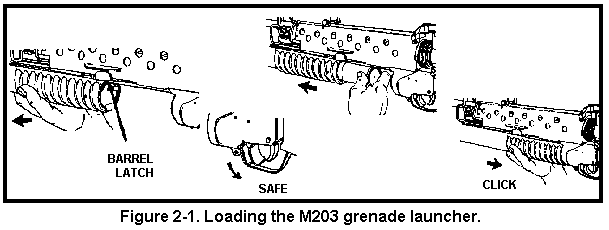
OPERATION AND FUNCTION
This chapter discusses the operation of the M203 grenade launcher and its function when loaded with ammunition.
The grenadier's operations include loading, unloading, and firing the weapon. The weapon uses a high-low propulsion system to fire a 40-mm round. The firing pin strikes the primer, whose flash ignites the propellant in the brass powder-charge cup inside the high-pressure chamber. The burning propellant produces 35,000 psi chamber pressure, which ruptures the brass powder-charge cup at the vent holes and allows the gases to escape to the low-pressure chamber in the cartridge case. There the pressure drops to 3,000 psi and propels the grenade from the muzzle at a velocity of 250 fps. The grenade's 37,000 rpm right-hand spin stabilizes the grenade during flight and applies enough rotational force to arm the fuze. The weapon is unloaded with the barrel open and fired from a closed bolt. The launcher must be cocked before it can be placed on SAFE.
2-2. LOADING
To load the weapon, the grenadier must first press the barrel latch and slide
the barrel forward. Once the barrel is in the forward position, the grenadier
places the weapon on SAFE. Then he inserts clean, dry, undented ammunition
into the chamber and slides the barrel rearward until it locks with an
audible click (Figure 2-1).

| WARNING |
|---|
KEEP THE MUZZLE POINTED DOWNRANGE AND CLEAR OF ALL |
2-3. UNLOADING
To unload the grenade launcher, the grenadier must first depress the barrel
latch and move the barrel forward. The cartridge case or round should
automatically eject. If the case is stuck, he taps it with a cleaning rod to
remove it (Figure 2-2). He places the weapon on SAFE, then slides the barrel
rearward, locking it to the breech.
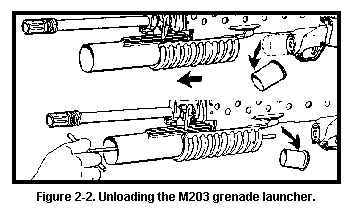
| WARNING |
|---|
IF THE WEAPON HAS NOT BEEN FIRED, AVOID DETONATION
BY EITHER |
Grenadiers can recognize and correct a stoppage if they know how the weapon functions. Loading a round into the chamber and pulling the trigger begin the parts of the weapon functioning in a cycle. Many of the actions occur at the same time, but are separated here for the purpose of explanation or illustration.
a. Unlocking. The cycle begins when the grenadier depresses the barrel latch to unlock the barrel assembly and slides the barrel assembly forward (Figure 2-3).
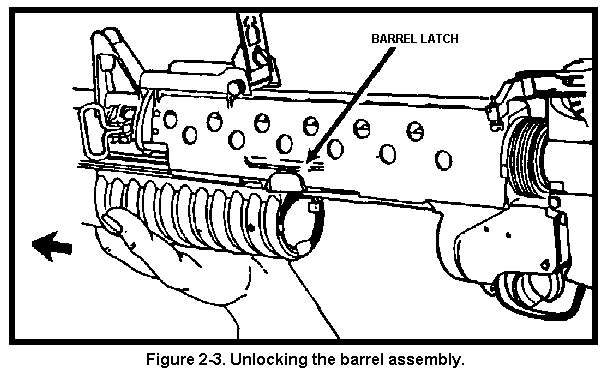
b. Cocking. The grenadier moves the barrel assembly forward then backward to cock the weapon. As the barrel assembly moves, it takes with it the barrel extension. Their movement causes the following to occur:
(2) The movement of the cocking lever in turn forces the spring-loaded firing pin to the rear.
(3) The spring-loaded follower also moves forward with the barrel extension.
(4) The barrel assembly continues forward, and as it does so, the barrel extension disengages from the cocking lever, which is then held down by the follower.
(5) The barrel assembly moves rearward, forcing the follower to the rear.
(6) The cocking lever again engages the barrel extension, which causes the firing pin to move slightly forward and engage the primary trigger sear, which cocks the weapon (Figure 2-4).
c. Extracting. Extracting and cocking occur at the same time. As the grenadier opens the barrel assembly, a spring-loaded extractor keeps the live round or spent cartridge case seated against the receiver until the barrel clears the cartridge case (Figure 2-5).

d. Ejecting. The spring-loaded ejector pushes the live round or spent cartridge case from the barrel assembly (Figure 2-6).
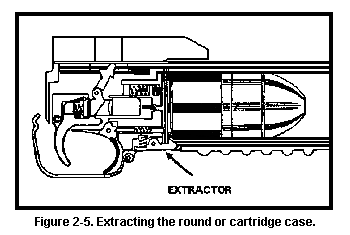

e. Loading. With the barrel assembly open, the grenadier inserts a round into the breech end of the barrel (Figure 2-7).
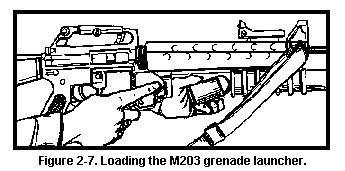
f. Chambering. As the grenadier closes the breech end of the barrel assembly, the extractor contacts the rim of the cartridge and seats (chambers) the round firmly (Figure 2-8).

g. Locking. As the barrel assembly closes, the barrel latch engages it. The cocking lever engages the barrel extension so that it cannot move forward along the receiver assembly.
h. Firing. When the grenadier pulls the trigger, the primary trigger sear disengages from the bottom sear surface of the firing pin. This releases the spring-driven firing pin, forcing it forward against the cartridge primer (Figure 2-9).
